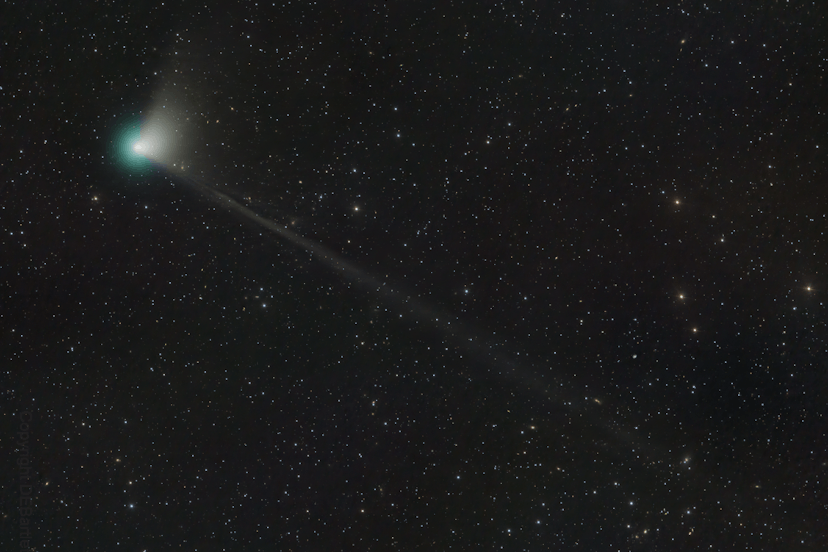A Super Rare, Bright Comet Will Pass By Earth In Early February
Don’t miss this once-in-a-lifetime event — literally.

Time to mark your calendars because you will not want to miss this: In the next few weeks, an extremely rare comet is set to pass through the sky — that could even be visible to the naked eye. And when we say this comet is extremely rare, we mean it. Comet C/2022 E3 (ZTF) has not come this close to Earth since the Upper Paleolithic period. Here’s what you need to know.
C/2022 E3 (ZTF) is going to make history.
The rare comet, C/2022 E3 (ZTF), was first discovered by scientists less than a year ago using the wide-field survey camera at the Zwicky Transient Facility. In March 2022, the comet was spotted in Jupiter’s orbit. And now it’s headed our way. The comet is at the edge of our solar system, but it will become visible from Earth in a few weeks.
"Most known long-period comets have been seen only once in recorded history because their orbital periods are so, well, long," NASA says, per CBS News. "Countless more unknown long-period comets have never been seen by human eyes. Some have orbits so long that the last time they passed through the inner solar system, our species did not yet exist," NASA continues.
The comet is believed to come from the Oort Cloud, the most distant region of our solar system, which has been called the “home of the comets,” particularly long-period comets. NASA explains that a long-period comet takes over 200 years to orbit the Sun (comets that take under 200 years are called short-period comets).
With a helpful interactive tool, you can track C/200 E3 (ZTF) in the sky.
TheSkyLive.com has a live tool that allows you to follow and track any object in space relative to where you are. You can set your area, then the object you want to search, and the interactive map will pop up, showing the object in real time.
For example, if you see our location as New York and search for C/2022 E3 (ZTF), you can see the comet up in space and get the exact coordinates, including its ascension, magnitude, and distance from the Sun and Earth (which is 42.76 million kilometers at the time of publishing).
This tool might not make much sense to a novice skywatcher, but it can be super helpful for those who want to plan where to look for the comet and when.
When will the C/200 E3 (ZTF) comet pass by Earth?
NASA astronomers say the comet will be closest to the Sun on Jan. 12, and it will make its closest sweep by Earth on Feb. 1 and Feb. 2, which will be the best time to try and catch it.
What are you looking for, though? This comet glows green and has a really long tail.
“Current images of C/2022 E3 (ZTF) show its coma, a surrounding halo of gas and dust, glowing with a greenish hue and a long but faint cometary tail extending from its main body,” Space.com explains.
How can I watch this rare comet with my kids?
To see the comet with the naked eye, it needs to continue its trend of being as bright and green as it has been. The brighter it stays, the easier it will be to spot with the naked eye. You’re more likely to be able to see it with the naked eye if you’re away from city lights and the Moon isn’t too bright.
However, if the naked eye can’t catch the comet, binoculars should be all you and the kiddos need to catch this once-in-a-lifetime sky show.
“Those in the northern hemisphere will be able to see the comet in the morning during January, while those in the southern hemisphere will be able to see it in early February,” CBS News notes.
From there, all the typical suggestions apply: Dress for the weather and expect to spend some time looking up at the sky because the longer you’re there, the more likely you are to spot C/2022 E3 (ZTF) shooting its way through your view.
When will this comet pass by again?
While seeing a comet for the first time is outstandingly cool, catching the C/2022 E3 (ZTF) is literally a once-in-a-lifetime opportunity and then some. It’s not going to pass by Earth again for a really long time.
“We don't have an estimate for the furthest it will get from the Earth yet — estimates vary — but if it does return it won't be for at least 50,000 years," Jessica Lee, an astronomer with the Royal Observatory Greenwich, told Newsweek. "Some predictions suggest that the orbit of this comet is so eccentric it's no longer in an orbit-so it's not going to return at all and will just keep going."
Don’t forget to mark your calendars!